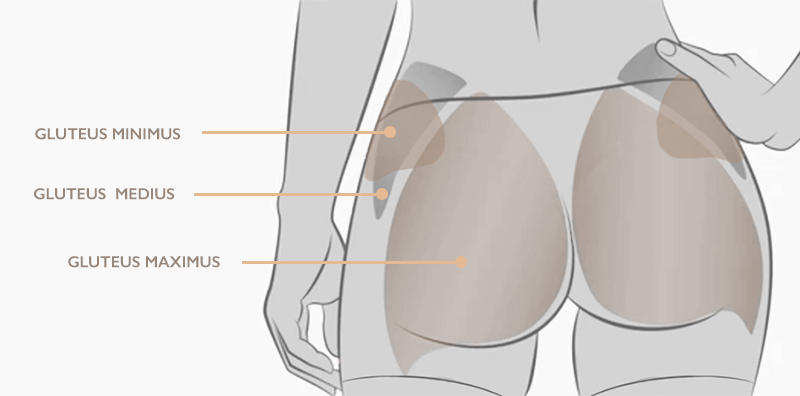The glutes, otherwise known as your butt, are the largest muscle group in the body. They play a key role in moving the hips and thighs, and are the engines powering lower-body movements such as running, jumping, and stair climbing. The glutes also help keep the body correctly aligned, protecting against injury.1
<< Spotlight >>
Glute Anatomy
Here’s an easy breakdown of the glute muscles you’ll want to target.
The glutes consist of three major muscles.
Gluteus maximus makes up the most of your butt and is mostly responsible for its shape. Its function is hip extension (e.g.moving thigh backward) and abduction (moving thigh to the side), and rotating the hip outward.
Gluteus medius is on the sides of your hips, sits slighter higher than the other muscles, and gives some shape to the upper butt. It is responsible for hip extension, rotating the hip inward, and during movement helps to keep the pelvis stable.
Gluteus minimus, is also on the sides of your hips, but lower than the gluteus medius. It is deepest and smallest of the glute muscles, and performs a similar function as gluteus medius.

Main Types of Glute Exercises
A well-balanced routine should include different types of glute exercises. Butt exercises can be roughly dived into 3 categories. Include at least one movement from each category per workout to target your glutes from every angle.
Glute Exercise Library
Glute Workouts
Why Strengthen Your Glutes
Stronger Glutes, Stronger Body
Sitting for long periods is associated with weak glutes, especially sitting with poor posture. So much so, it’s even got a name (or two) – gluteal amnesia or “dead butt syndrome”. The extended periods of inactivity and pressure on our glutes from endless sitting leaves many of us with weak, poorly functioning glute muscles and tight hip flexors.
Being such an important player means that when the glutes are weak, it can throw your whole body out of whack and have far reaching effects. The muscles and joints around them step in to absorb the strain, which can lead to a plethora of problems, such as chronic low back pain, hamstring strains, ankle sprains, and knee injuries. And it can negatively affect athletic performance.
So whether you want to build a bigger booty or a better-functioning body, the answer is the same. It’s time to step up and strengthen your glutes.234
For workout ideas check out our workout plans and the best exercises for different body parts.

